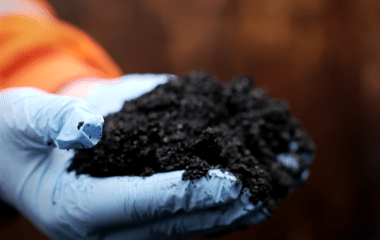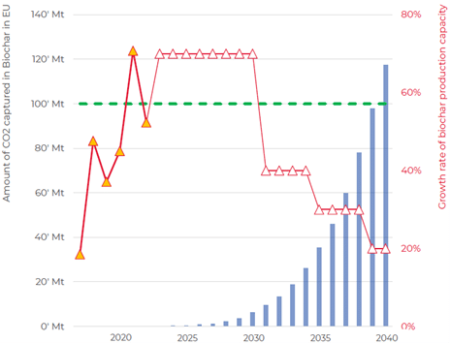
CO2 sequestration: is biochar the obvious candidate?
Limiting greenhouse gas emissions is the great challenge of our time. In this race against time, innovative, sustainable and affordable solutions are in short supply. That’s why, with its partners, Haffner Energy wants to put the spotlight on biochar, one of the co-products of biomass thermolysis. As a carbon sink that sequesters more CO2 than the process emits, biochar has a role to play in the energy mix to reduce our carbon emissions.
Biomass thermolysis: a proprietary technology with multiple benefits
Haffner Energy’s unique technology is based on the thermolysis of biomass. The value of this process lies, firstly, in the use of a wide variety of organic materials – biomass, in other words – available for non-competitive uses. Secondly, it co-produces biochar, a high value-added vegetable coal.
This “new black gold” can easily be put to good use in the energy transition. Indeed, biochar acts as a stable carbon sink, sequestering the CO2 contained in the biomass at the end of the process. The European Biochar Industry Consortium (EBI) estimates that biochar produced in the EU could sequester 6 million tons (Mt) of CO2 by 2030 and over 100 Mt by 2040. In its report “Climate Change 2022: Mitigation of Climate Change“(1), the IPCC states that biochar has a global potential to eliminate 2.6 billion tons of CO2 per year.

On its own scale, Haffner Energy offers a turnkey solution to meet the objectives of decarbonizing industrial sites – a priority in the face of the climate emergency – but also to boost the economic competitiveness of the players involved. Biochar has a wide range of applications: agricultural and industrial applications, and economic value through the associated carbon removal certificates (CORCs)…
CO2 storage: biochar, a better understanding for better use
Biochar is part of carbon dioxide removal (CDR). CO2 removal processes can be stored in various carbon reservoirs: geological, terrestrial, oceanic or in the form of products with varying degrees of permanence.
Carbon removal certificates (CORCs) cover these different technologies and sequestration methods. CORCs are only traded on the voluntary carbon market, and to date, Biochar Carbon Removal already accounts for the vast majority of carbon removals delivered to this market.
While CO2 storage via biochar production is currently marginal compared with CCS (Carbon Capture and Storage) techniques, European authorities are currently leading discussions to provide a regulatory framework enabling certification of these carbon removals with a view to their integration into our climate policies to achieve carbon neutrality by 2050. This is a new opportunity for the various uses of biochar, whose qualities are becoming increasingly well understood.
The subject of CO2 storage and disposal is an important pillar in achieving our ambitions of carbon neutrality in 2050. Europe needs a clear, reliable and inclusive framework for the various technologies to avoid greenwashing.
A recent study published at the end of 2023(2), by Danish geologists who compared the reflectance(3) of commercial biochar with inertinite(4) (Sanei et al., 2023), argues in favor of the latter. The aim of this study was to test the stability of biochar by comparing its properties with those of inertinite, the most stable organic compound in the earth’s crust. Analyses carried out on the biochar, in particular its reflectance, enabled the researchers to establish that 76% of the biochars studied could be considered as inertinite, estimating that it would take millions of years before the carbon in these biochars would be degraded!
Biochar: a unique co-product for multiple uses
To take things a step further, Haffner Energy approached ENSAIA, an agricultural engineering school based in Nancy and a member of the Université de Lorraine, to carry out experiments with the biochar produced by its equipment and assess its value in agriculture.These trials,in association with 3rd year students specializing in DEFI (Sustainable Development of Agricultural Sectors), the URAFPA and LAE research laboratories and the AgroMétha Chair, are divided into two parts:
- An agronomic part, in which biochar is tested as an amendment on a spring barley crop under controlled conditions. Two types of soil, widely found in northeastern France (a sandy Alsatian soil and a calcareous clay soil from Lorraine), are being tested, which will provide results representative of the local context. TThe aim is to measure the potential impact of biochar application on yield, but also to identify the effect of biochar on the availability of nitrogen, an essential nutrient, and to observe the soil’s capacity to retain water.
- A methanization section, in which biochar is tested as a methanization additive and its effect on biogas production is observed. This trial is particularly interesting as the Grand Est region accounts for a significant proportion of methanization units in France (nearly 20% according to a map drawn up by ADEME), and the sector continues to grow.
In the race for neutrality, no stone can be left unturned.
At a crucial time, when Europe is aiming for carbon neutrality by 2050, biochar is clearly a high-performance solution that should not be overlooked. Alongside other technologies, it could help offset our emissions.
Haffner Energy is calling for biochar’s scientifically proven permanence to be officially recognized as a carbon sequestration solution. Eager to develop concrete outlets for the biochar co-produced by its plants, the Company signed a partnership agreement at the beginning of the year with a major player in biochar distribution in Europe. This agreement in principle will facilitate the sale of biochar produced by future customers, and is therefore a guarantee of security for future projects.
(1) IPCC: “Climate Change 2022: Mitigation of Climate Change” report, part three of the sixth assessment cycle (AR6).
(2) Source: Sanei H., Rudra A., Przyswitt Z. M. M., Kousted S., Sindlev M. B., Zheng X., Nielsen S. B., Petersen H. I., 2023. Évaluation de la permanence du biochar : An inertinite benchmark. Dans International Journal of Coal Geology Volume 281, 5 janvier 2024, 104409.
(3) Reflectance: proportion of light reflected by the surface of a material. It is generally expressed as a percentage and is a commonly used parameter in petrology (the discipline concerned with the mechanisms of rock formation and transformation).
(4) Inertinite: organic matter that has undergone a kind of fossilization in sedimentary rocks under the effect of temperature, pressure and time.